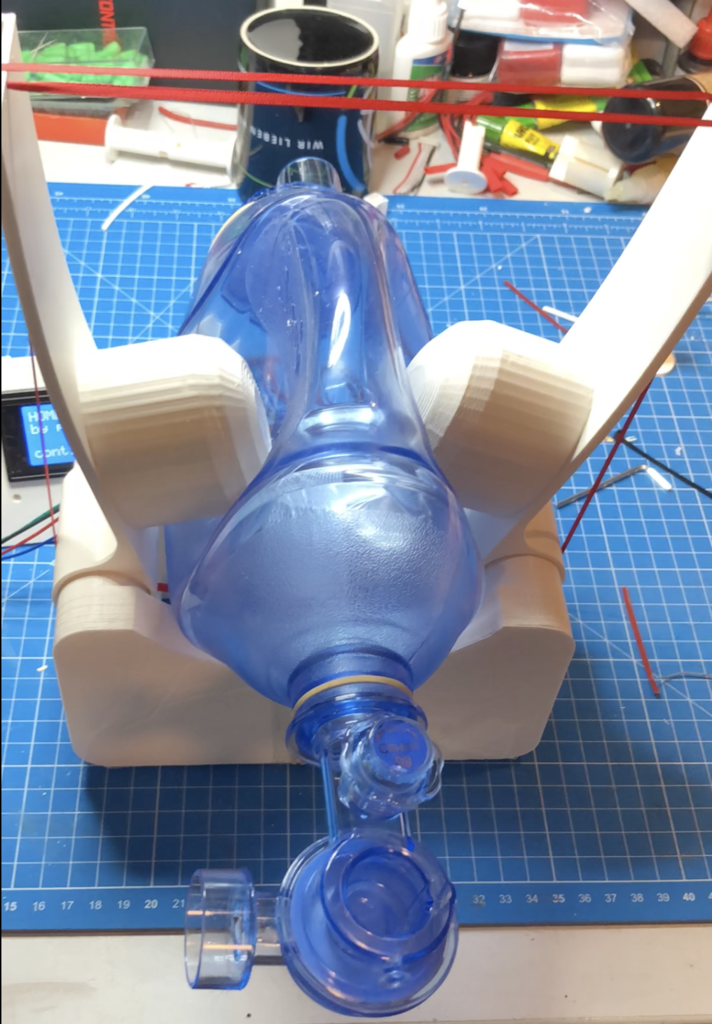
OpenVent - 3D printable BVM Ventilator, Design A1
thingiverse
During the Corona (COVID-19) pandemic it became clear that a lack of medical equipment can cause severe damage. Often, even simple equipment and designs are helpful as long as no professional equipment is available. This repository contains generic information about an open-source ventilator device. The main purpose of this project is to build a ventilator when no professional and medical equipment is available. Easy-to-assemble components are used with a clear focus on simplicity, availability, and scalability. This project began as part of the hackathon #WirvsVirus of the German government. Please check the full disclaimer before proceeding: The material and documentation provided here come with no warranties explicit or implied. No material on this site is intended to provide medical advice. All designs are intended for investigational use only. This site does not represent any official policies or procedures. The project is provided "as is", without warranty of any kind, express or implied, including but not limited to the warranties of merchantability, fitness for a particular purpose, and noninfringement. In no event shall the authors or copyright holders be liable for any claim, damages, or other liability, whether in an action of contract, tort, or otherwise, arising from, out of, or in connection with the software or the use or other dealings in the software. Only use this repository, designs, documentation, or any provided information if you accept the above disclaimer. Additional discussion, documentation, source code, electronics, and sensor design are available at GitHub (https://github.com/mhollfelder/openvent) and YouTube (https://www.youtube.com/channel/UCw9h6QsYEKY2sfZIYBNuHvw). This device represents an extension/variant based on our initial design A0. Further extensions and upgrades will be posted here as well. Please check those too. General concept: An AMBU-bag is used as a pressure reservoir, which already features an O2 inlet (O2 concentration is crucial for patients with acute respiratory syndrome) and several safety features including overpressure and bypass valves. Being standard for emergency help, these bags are available in substantial volumes. A motorized and microcontroller+sensor-controlled setup squeezes the bag at the right pattern, supporting assist-, pressure-, volume-, and flow-control ventilation and exhaled gas measurements and filters. All components are based on open-source and commonly accessible parts; especially for the mechanics, the objective is to be scalable in production and hence fully 3D-printable. Only the motor and its screws as well as the belt are not printed. Standard stepper motors such as Nema17 or 23 are proposed. Electronics, sensors, and software are covered in our GitHub pages. Improvements: Experience based on the initial prototype has shown that a punch (one or two) is required, which ideally have a fix point to avoid shift over time and that a translation may be desirable to balance force and speed for a wider range of suitable motors. Especially for low-cost and excellent availability reasons, we would like to enable a Nema-17 (or at least a Nema-23) type motor. We experimented with different diameter rotors (r=6.5 to 65) and added two tilting bridge arms actuated by ropes as depicted (alternatively, a gear set within the base could easily replace the ropes). Both offer variability in the translation, the 'rope-variant' even a pulley loop. Experiences: This design has proven to be robust while still simple in design. Print-complexity goes up due to the additional tilt arms. On standard printers with less than 20cmx20cm build area, this would typically require two sequential print jobs. Still, it can be done in less than 18 hours at 0.2mm layer resolution. Robustness has higher priority than printing time. However, such high resolution is not required for the design, hence additional speed-up potential is given. While this design enables 'smaller' motor variants such as a Nema-17, these can become very warm under continuous maximum load, and thus the rotor should be printed from high-temperature PLA/material. Geared Nema-17 (1:5) have been tried as potential alternatives, but their ratio is too high versus required ventilation speed. This would need to be mechanically compensated. Nema-23 appears to be a very robust and simple choice. More detailed discussions on our GitHub pages.
With this file you will be able to print OpenVent - 3D printable BVM Ventilator, Design A1 with your 3D printer. Click on the button and save the file on your computer to work, edit or customize your design. You can also find more 3D designs for printers on OpenVent - 3D printable BVM Ventilator, Design A1.
